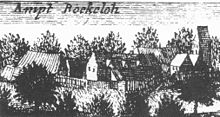Bokeloh Castle
Castle Bokeloh , as Veste Bokeloh within the meaning of the feast house called, was by the Minden bishop in the 13th century Ludolf built castle in Bokeloh in Lower Saxony . The Counts of Schaumburg established the seat of the Bokeloh office in it in the 15th century . After the office was dissolved in 1819, most of the buildings were demolished.
Building description
The former castle complex is a Niederungsburg at the southwestern end of Bokeloh in the extensive lowland area of the Westaue . The Burgplatz and the area of the outer bailey are slightly elevated. Both were surrounded by moats , the depressions of which can still be seen.

Pictorial representations of the castle in Bokeloh have not survived. A drawing from 1681 shows it in a state when it was already the official residence. At that time, the complex was a loose collection of buildings with a single standing castle tower. The foundations of a square tower were found during construction work in the 19th century. The current buildings, some of which stand on the medieval foundation walls and a cellar vault, date back to the 16th century. A map dating from around the 17th to the 18th century shows the castle as a three-wing complex open to the southwest. The adjacent buildings included a brewery, two residential buildings, a wing, a horse stable and a peat shower.
When the Bokeloh office was dissolved in 1819, several buildings were demolished, such as the office building, the Vorwerk building, the horse stable, the pig house, the wagon shed, the Darrhaus and a barn. Only the office building and an auxiliary building remained untouched. The chief forester took up his office in the office building. The outbuilding was used by officials of the Blumenau office working in Bokeloh, and partly as a storage room for grain. In the 1910s, the castle buildings were rebuilt and extensions were added. Today it is privately owned and used for residential purposes.
Whether the building material of the castle building, as described in the written records, came from the Tienberg was checked in 1976. This was done through comparative studies of the striking red sandstone by the Lower Saxony State Office for Soil Research . Due to their petrographic quality, the stones can be assigned to the middle red sandstone . It was considered likely that the stones came from the Tienberg, as similar rocks only exist in the Bodenwerder area and transport from there is unlikely.
history
The Minden Bishop Wilhelm I built the castle in Bokeloh in 1242. His successor Johann continued to fortify the castle and, according to the Minden bishops chronicles , had a castle tower built. In the chronicles of the bishops, the castle is mentioned as "Castrum Novum" and was first mentioned in documents as castrum Boklo in 1317 . The castle played an important territorial role in the middle of the 13th century with regard to the Counts of Roden in the Wunstorf area . The castle was not a pure bishop's castle, as two castle men of Count von Roden were sitting on it. In return, the count had granted the Minden bishop the right to break stones for the construction of the castle on Tienberg, north of Bokeloh, and to cut wood in the forest. It is believed that the partnership between the Bishop of Minden and the Count of Roden was based on forming a coalition against the Count of Schaumburg and his plans to clear the Dülwald . The reason for the construction of the castle in Bokeloh is also assumed to be in the protection of the episcopal possessions around Idensen with the Sigward Church .
The Minden bishop Ludwig gave the castle to the dukes of Braunschweig and Lüneburg as pledged property in the 14th century . Other pawnbrokers followed until the castle came to the Counts of Schaumburg.
literature
- Heinrich Lathwesen: The Bokeloh office with its villages Bokeloh, Idensen, Mesmerode , Wunstorf 1981
- Joachim Homeyer: Bokeloh - a castle of the bishops of Minden in the 13th century: "castrum novum in loco, qui dicitur Carnewinckl" in: Yearbook of the Society for Lower Saxony Church History , Volume 82, Hanover 1984
- Hans-Wilhelm Heine : Schaumburger Land - Burgenland , in the series: Guide to the prehistory and early history of Lower Saxony . (29), Oldenburg 2010, published by the Lower Saxony State Office for Monument Preservation and the Archaeological Commission for Lower Saxony , ISBN 978-3-89995-673-3
Web links
- Entry by Stefan Eismann about Schloss Bokeloh in the scientific database " EBIDAT " of the European Castle Institute
- Bokeloh Castle in the Lower Saxony Monument Atlas
Coordinates: 52 ° 24 ′ 38.3 " N , 9 ° 22 ′ 22.9" E

